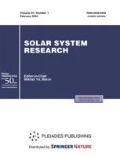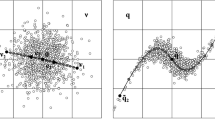Abstract
The probability of an asteroid colliding with a planet can be estimated by the Monte Carlo method, in particular, through the statistical simulation of the possible initial conditions for the motion of an asteroid based on the probability density distribution set by the respective covariance matrix to be further projected with the orbital model onto the supposed time point of the collision. Hence, the collision probability is calculated as the ratio between the number of projected (virtual) asteroids striking the planet and their total number. The main problem is that different elements of the initial conditions (orbit or state vector) are correlated and, therefore, cannot be simulated independently. These correlations are reflected in the nondiagonal covariance matrix of the solution. The matrix is diagonalized by an orthogonal transformation. In the uncertainty domain constructed from the diagonal matrix elements, the initial values for each of the six orbital elements are simulated independently from the other elements, but with the accounting for their normal distribution. The program for calculating the normal distribution is based on the central limit theorem. Each sample of the initial values for the six orbital elements is transferred to the initial reference frame using an inverse transformation. Then, numerical integration is used to track the asteroid’s motion along the respective orbit to predict a possible impact event. Asteroids 99942 Apophis and 2007 WD5 are used as examples to show that disregarding the correlations when diagonalizing the covariance matrix to set the initial conditions may seriously distort the collision probability estimates. The paper gives the probabilities of the collisions of Apophis with the Earth and asteroid 2007 WD5 with Mars calculated by the author from observation sets showing nonzero collision probabilities. The author’s estimates are compared to those calculated by NASA.
Similar content being viewed by others
References
Bykova, L.E. and Galushina, T.Yu., Evolution of the Probable Region of Asteroid 99942 Apophis’ Motion, in Okolozemnaya astronomiya — 2007 (Near-Earth Astronomy), Nal’chik: Izd. M. i V. Kotlyarovy, 2008, pp. 48–54.
Chernitsov, A.M., Algorithms for Determining the Possible Regions of Motions for Minor Bodies in the Solar System, Extended Abstract of Cand. Sci. (Phys.-Math.) Dissertation, Tomsk, 2000.
Chesley, S., Chodas, P., and Yeomans, D., 2007 WD5 Mars Collision Effectively Ruled Out — Impact Odds Now 1 in 10000, http://neo.jpl.nasa.gov/news/news156.html, 2008.
Chodas, P.W., Estimating Impact Probability Using Monte Carlo Techniques, Bull. Amer. Astron. Soc., 2000, vol. 32, p. 862.
Galushina, T.Yu., On Dynamics of Near-Earth Asteroids Passing Near the 5:2 Resonance with Jupiter, in Issled. po ballistike i smezhnym voprosam mekh. (Res. on Ballistics and Related Problems of Mech.), 2002, issue 5, pp. 126–129.
Giorgini, J.D., Benner, L.A.M., Ostro, S.J., et al., Predicting of the Earth Encounters of (99942) Apophis, Icarus, 2008, vol. 193, pp. 1–19.
Ivashkin, V.V. and Stikhno, K.A., On the Problem of Correcting the Orbit of the Near-Earth Asteroid (99942) Apophis, Dokl. Akad. Nauk, 2008, vol. 419, no. 5, pp. 624–627 [Dokl. (Engl. Transl.), vol. 419, no. 5, pp.].
Lyapunov, A.M., A New Form of the Probability Limit Theorem, in Sobr. soch. T. 1 (Coll. Works, vol. 1), Moscow, 1954, p. 157.
Milani, A., Chesley, S.R., and Valsecchi, G.B., Asteroid Close Approaches: Analysis and Potential Impact Detection, in Asteroids III, Bottke, W., Cellino, A., Paolicchi, P., and Binzel, R., Eds., Univ. of Arizona Press, 2000, pp. 55–69.
Nakamura, T. and Yoshikawa, M., Orbital Evolution of Giant Comet-Like Objects, Celest. Mech. and Dyn. Astron., 1993, vol. 57, nos. 1–2, pp. 113–121.
Sobol’, I.M., Metod Monte-Karlo (Monte Carlo Method), Moscow: Nauka, 1968.
Vinogradova, T.A., Kochetova, O.M., Chernetenko, Yu.A., et al., The Orbit of Asteroid (99942) Apophis Determined from Optical and Radar Observations, Astron. Vestn., 2008, vol. 42, no. 4, pp. 291–300.
Virtanen, J., Muinonen, K., and Bowell, E., Statistical Ranging of Asteroid Orbits, Icarus, 2001, vol. 154, no. 2, pp. 412–431.
Williams, G.V., MPEC 2004-Y66, in MPC, Cambridge, MA 02138, USA, 2004.
Yeomans, D., Chesley, S., and Chodas, P., Near-Earth Asteroid 2004 MN4 Reaches Highest Score to Date on Hazard Scale, http://neo.jpl.nasa.gov/news/news146.html, 2004.
Yeomans, D., Asteroid 2007 WD5, http://neo.jpl.nasa.gov/2007wd5/, 2008.
Zabotin, A.S. and Medvedev, Yu.D., A Technique for Calculating the Initial Data to Determine the Probable Regions of Minor Bodies Motion, Tez. dokl. 2-i Vseros. konf. “Fundamental’noe i prikladnoe koordinatno-vremennoe i navigatsionnoe obespechenie (KVNO-2007)” (Abstr. 2nd All-Rus. Conf. “United Positioning, Navigation and Timing System: Fundamental and Applied Aspects (PNT-2007)”), St.-Petersburg: IPA RAN, 2007, pp. 220–221.
Zamarashkina, M.D., Probable Evolution of the Orbit of Comet Shoemaker-Levy 9, in Tr. IPA RAN (Works of Appl. Astron. Inst., Rus. Sci. Acad.), St. Petersburg: IPA RAN, 2004, no. 11, pp. 124–136.
Author information
Authors and Affiliations
Additional information
Original Russian Text © N.B. Zheleznov, 2010, published in Astronomicheskii Vestnik, 2010, Vol. 44, No. 2, pp. 150–157.
Rights and permissions
About this article
Cite this article
Zheleznov, N.B. The influence of the correlations between an asteroid’s orbital parameters on the estimation of the probability of planetary collision by the Monte Carlo method. Sol Syst Res 44, 136–143 (2010). https://doi.org/10.1134/S0038094610020061
Received:
Published:
Issue Date:
DOI: https://doi.org/10.1134/S0038094610020061



